|

On eBay Now...
🔥 Fine Vintage Old Southwest Navajo Indian Portrait Oil Painting, Gertrude RUST For Sale
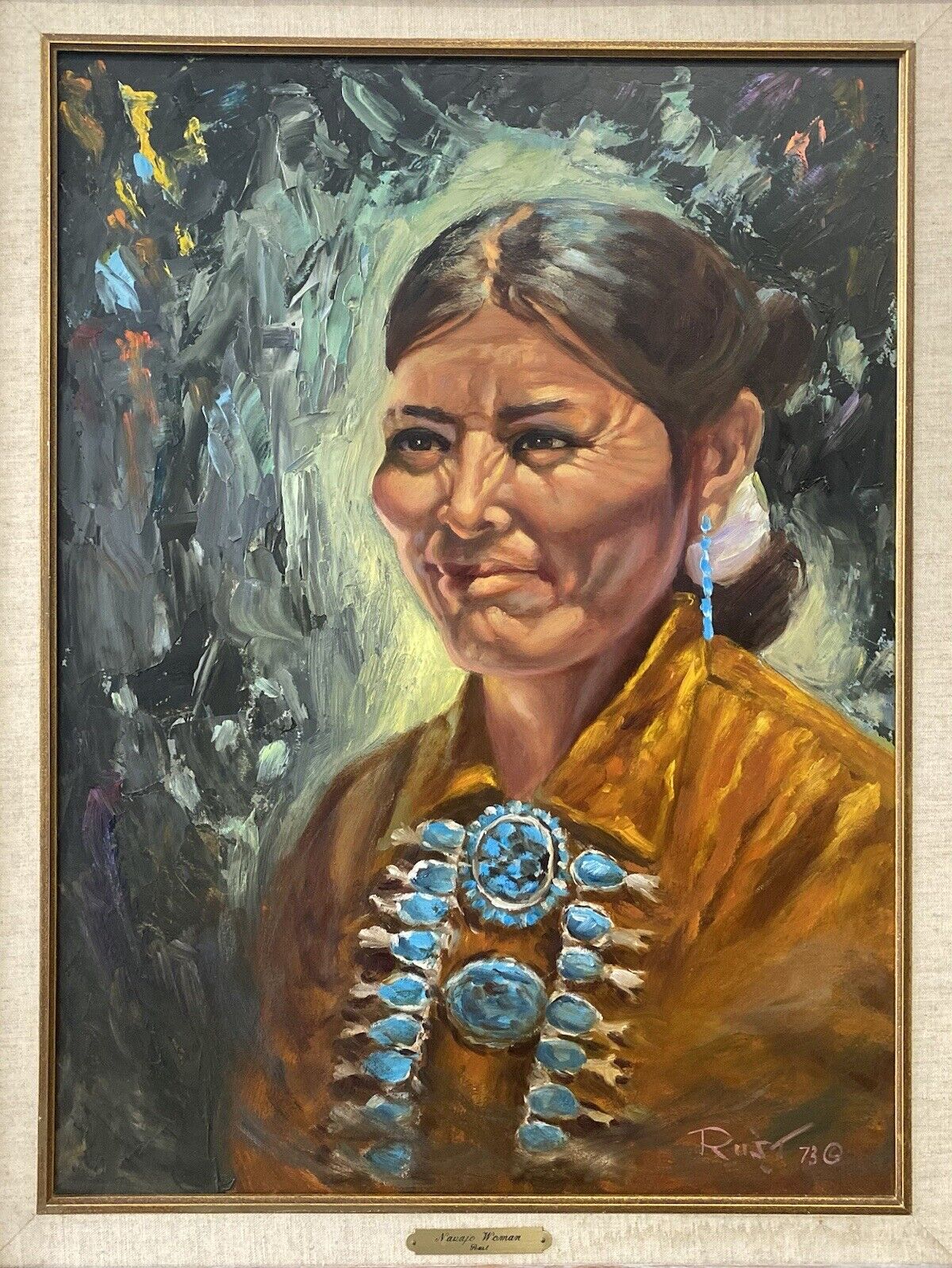
When you click on links to various merchants on this site and make a purchase, this can result in this site earning a commission. Affiliate programs and affiliations include, but are not limited to, the eBay Partner Network.

🔥 Fine Vintage Old Southwest Navajo Indian Portrait Oil Painting, Gertrude RUST:
$1350.00
This is a beautiful andFine Vintage Old Southwest Navajo Indian Portrait Oil Painting on Masonite, by esteemed Arizona - California Southwestern genre painter, and early member of the Palm Desert Palette Club, Gertrude Rust (1907 - 1996.) This artwork depicts the vivid portrait of an old Navajo woman, who exudes pride and hopefulness. Her facial features display a sense of warmth and welcoming, and her turquoise squash blossom necklace is painted with great attention to detail. In the background you can see colorful sparks of kinetic color in various hues. Signed and dated: "Rust '73" in the lower right corner. Additionally, a brass plaque affixed to the front of the frame reads: "Navajo Woman - RUST." Approximately 28 x 34 1/4 x 2 inches (including frame.) Actual artwork is approximately 18 x 24 inches. Very good condition for age, with some light scuffing and edge wear to the original period wood frame. Acquired from an old collection in Los Angeles County, California. If you like what you see, I encourage you to make an Offer. Please check out my other listings for more wonderful and unique artworks!
About the Artist:
Gertrude Rust (1907 - 1996)Rust was a well-known artist who specializes in Western and Southwest themes and designs.Gertrude Irene Rust (1907 - 1996) was born in Colorado Springs, Colorado. She was a former deputy sheriff, San Bernardino County, California. A resident of Pinetop and Phoenix, Arizona for many years, where she gained fame and renown as a western artist. She was a gifted artist and musician and was also an ordained minister of the Foursquare Church, and was a graduate of L.I.F.E. Bible College in 1954.DEATH: GERTRUDE IRENE RUSTPublished:Sept 24, 1996, 12:00 a.m. MDT
In those days, Highway 111 was a meandering two-lane. Tourists drove slowly and stopped to visit the oddball trio who hung out behind the current-day Desert Crossing Shopping Center. Along with Chisnall, there was the rockologist Chuckawalla Slim and Andy the Donkeyman, who sold burro rides for 25 cents. Chevoor said a quick hello to the rockhound and the burros, then zeroed in on Chisnall. She soon convinced the roadside artist to give her painting lessons. One day weeks later Evie (as she was called) walked into the Shadow Mountain Club and suggested to hostess Thirza Schenk–also a student of Chisnall’s–that they display a few of her fledgling artistic efforts. Unframed landscapes were unceremoniously propped on tables here and there in the modernist stone, wood and glass clubhouse. It seems there were more painters hidden amongst the club membership. Soon 33 additional paintings appeared on the tables. In the Spring of 1961, Evelyn and Thirza–along with their friend Irene Fenton–founded The Shadow Mountain Palette Club. It would become, for a time, the most popular art club in the desert. The Club was part of the Do-It-Yourself art movement that overtook the country in the 1950s and ‘60s. As different from the commercial art scene as it could be, the amateur movement “tested the nature and limits of the modern artist’s identity and the values of art-making in the modern world,” wrote art historian Kim Grant in a paper calledPaint and Be Happy. Grant took her title from Winston Churchill who spurred the fad with his bookPainting as a Pastime.“Happy are the painters,” he wrote, “for they shall not be lonely.” And happy are those who write about the painters for they shall not be lonely, either. During my trip through the history of the club, I’ve found excellent company in a champion trap shooter, a female sheriff who drew mugshots, a transplant from Germany descended from the Grimm fairy tale family, as well as famous names such as Milford Zornes, Jimmy Swinnerton and modernist Dorr Bothwell. They all painted and taught at the Shadow Mountain Palette Club.
As art scholar Grant points out, the movement was driven by women, with a crew of housewife-painters leading the pack. One of the regulars at Shadow Mountain was a dentist’s wife named Margaret Tyler. The artist’s son, Bob Tyler, is today a docent at the Historical Society of Palm Desert. He remembers the group painting off of Highway 74 where the Bighorn Golf Club is today. “The bighorn sheep would wander down to watch them work,” Bob Tyler said. “It really mushroomed there in the 1960s.”
I’d heard about the Palette Club long agoin stories told by Bill Bender, Carl Bray and Desert Magazine gallery owner Ginger Renner. Former Palm Desert historical society president Hal Rover told me about the Club’s scrapbooks–five giant black binders—held in storage. I’d always meant to dig through them. But then, more recently, modernism swallowed the desert and many local history groups began to throw out anything not related to the trend. I worried that the binders might be subject to a purge so I got to work. The books were huge, heavy and unwieldy. When I picked them up, covers fell off and ancient dunescapes fluttered out. Inside, long-dead society columnists told tales of a populist uprising. You could open to any page and discover neglected artists waiting to be resurrected. I’m sharing some of the names and stories in hopes that other researchers will take over. The roll-call is long, but it’s worth reciting as so much inspiration is found here on the fringes of the sanctified art world. Studying the scrapbooks in chronological order, I learned that Evelyn, Irene and Thirza staged the very first Artists’ Ball on March 24, 1961, with prime rib on the menu and Jack Kerns orchestra on stage. At the club’s peak, as many as 500 guests attended the annual artists’ balls. (One of the earliest country clubs in the Valley, Shadow Mountain was known for its giant figure-eight pool, a novelty at the time. The golf club is still in operation and was recently purchased by a new owner, Lindi Biggi.) It’s hard to imagine Evelyn Chevoor’s hobo teacher Fred Chisnall at these society events. I picture him waiting out the festivities in his camper with a can of tuna and a cat. But Chisnall was connected to many name artists. He spread the word and soon his artist friends from around the Southland were coming out to teach classes. The scene was a hybrid of high society and punk anarchy. While the balls were formal country club affairs, the paint-outs in places like the Mecca Hills, Box Canyon and Pinyon Pines were more like the Bombay Beach art scene today: Scruffy and free. Early in the 1960s the club gained momentum.The scene benefited from proximity to the Desert Magazine building on Highway 111 in Palm Desert. The magazine, at the time, was popularizing the desert and desert art all over the country. The very first demo was by Heiner Grimm. A forgotten artist Bill Bender told me about, Grimm was famous for illustrating Grimm’s fairy tiles on tile and porcelain. When President Eisenhower was in the desert, Grimm presented him with his own portrait in porcelain. The Palette Club then held an exuberant paint-out at Chester Spencer’s ranch in Yucca Valley. Spencer was an architectural designer and illustrator for Douglas Aircraft. Later field trips took the group to Paul Wilhelm’s 1000 Palms Oasis, and Thirza Schenk’s Snow Creek rock house. Charter member Frederick Doyle Penney (he lived on Silver Spur Trail in Palm Desert) chaired a field trip to Andreas Canyon. Penney had studied at Chouinard Art Institute in LA and the Art Students League in New York as well as the Chicago Art Institute. He had painted a number of ballerinas in his career, and upon first encounter with a smoke tree he said it reminded him of a floating dancer. A fly-in paint-out held at the Desert Air Hotel in Palm Desert featured a composite painting demonstration by Carl Bray (he supplied the foreground), Irene Fenton, Joseph Frey, Wilton McCoy (he did the smoke trees) and Sam Fleischman (foothills.) Wilton McCoy, author of the bookPainting the Desert, took the group to the Fish Traps Wash. Meanwhile, back at the figure eight pool, Keith Ward, a children’s book illustrator (The Black Stallion,Elsie the Cow) did poolside painting demos and eventually opened the Keith Ward Art School and Gallery in Palm Springs. Among the artists who enlivened the club, there was Irene Scoggin Bertrand (a Joshua Tree resident who had been a designer for MGM studios), Lettye Edens (she owned Edens’ art center in Indio), Sally Ward, Harriet Lake and George Coblentz, a topographical mapper in WWI and later an MGM artist. There was Lela Schade, who opened the Del Sol Art Gallery in Rancho Mirage, and Marjorie Schumacher, who had a studio at 32-603 Desert Vista Rd in Palm Springs. Goldie Powell Harding, a teacher of the dentist’s wife Margaret Tyler, had studied at Columbia University and was a widely traveled lecturer on modern art. John Hilton was a regular. Larry Sitter of Palm Springs (the late Terry Masters studied with him), R. Brownell McGrew and Snow Creek painter Axel Linus were on the board of directors. The illustrious James Swinnerton was an honorary lifetime member. Cathedral City modernist Val Samuelson was a frequent speaker and contest judge. The famous TV artist Jon Gnagy (he predated Bob Ross) was a guest instructor. Visiting painter and printmaker Dorr Bothwell brought modern influences; she was part of the Bay Area surrealist scene that included Lorser Feitleson and Helen Lundeberg. Another guest, Howard Burke, was an artist for the LA Examiner and drew the maps for theHappy Wanderers, a weekly travel TV show sponsored by Ford Motor Company. More Shadow Mountain names well-known to fans of California art include Ivan Messenger, Sterling Moak, Paul Lauritz and Joseph Frey, who opened his first studio in San Francisco in 1915. But my personal favorite is an unknown, Lela Hall Frank, who shares space with Annie Oakley in the Trapshooting Hall of Fame. Historical society docent Bob Tyler remembers Lela giving painting lessons to his mother; they hung out at the Trap and Skeet Club at Jackie Cochran’s Indio ranch. Bob’s own competitive shooting background was partly inspired by Lela, an eight-time national award winner. He still has a painting she painted for him at the Salton Sea. All the people who “shot trap” at the Salton Sea duck clubs coveted a Lela Hall Frank painting, Tyler says. Another favorite: Western artist Gertrude Rust. She was a deputy sheriff and forensic artist in Apple Valley who painted composite sketches of suspects from the descriptions given by witnesses. At one Palette Club gathering, Rust did a demo of her trade, asking men from the audience to pose for various body features. (Palm Desert founder Carl Henderson was the neck.) Rust lived in Indio and studied at Otis Art Institute; she was a frequent guest at the Riverside County Indio Date Festival, as were many of the Palette Club regulars. One of these artists who deserves more attention purely for his artistic skill is Robert Rishell. A frequent presence at the events, Rishell showed a dramatic grasp of shadows in his painting. He was pals with Swinnerton and John Hilton, and once painted Swinny’s portrait. He was one of the founders of the Oakland Museum and was a look-alike for John F. Kennedy. In 1965, Robert Rishell barely escaped a floodthat engulfed his trailer in Painted Canyon. His promising career was later cut short when he died of multiple myeloma at age 59. Also in 1965, a lovelorn Fred Chisnall holed up sick in his trailer. Carl Bray found him barely conscious and took him to his home, where he soon died. Evelyn Chevoor cried when she found out that Ol’ Paint (as she called her teacher) was gone. The following year, violence interrupted the festivities. The occasion was an art show at the Erawan Garden Hotel in Indian Wells. (Now the Miramonte Resort and Spa, the former Erawan recently was named a historic landmark by the Indian Wells Historic Preservation Foundation.) The Palette Club was staging their poolside exhibition and party when, suddenly, gunshots boomed. A Palette Club member shouted: “Murder! Murder!” The victim survived the attack by her crazed husband, who was apprehended after a chase on Dillon Road reaching speeds of 119 mph. Back at the hotel, painters packed up their easels as the forensics crew sampled blood stains on carpets and photographed a porcelain elephant from Vietnam which sustained a bullet wound. The art party was over. The episode marked a symbolic turning point; the group’s flame flickered slightly each year thereafter. By the 1970s—binder number five–the club veered toward cocktails and away from bohemia. The 60s were over, after all. One of the founders, Thirza Schenk Williams, died in 1971. Founder Irene Fenton died in 1977. Artists were getting married and leaving the fold to pursue domesticity. “Cupid Nabs Artist” read the headline as Angela Spencer wed Wilton McCoy. “Cupid’s Darts Keep Zinging” a society columnist said, as Palette Club photographer Avis Hebgen wed treasurer Harold Turner. A few remnant members of the Palette Club operated a storefront space on Hwy 111 until about 2008. Luce Felts and El Paseo dress shop owner Edith Morrey were some of the last of the crowd to pass away. A number of the men are known today in desert art circles: Darwin Duncan, Wilton McCoy, Fred Penney. The cocktail waitress with the Boston accent is forgotten. To honor Evie and her friends, you can walk out to Painters Path, the Palm Desert street named for Fred Chisnall (it’s now the trailhead for the popular Bump and Grind). This is where the happening began. Back in Evie’s day, the painters could see for miles from Coachella to Palm Springs and many a landscape artist was born right here. Today the view is hemmed in by buildings so you’ll need to use your imagination, but sit for a moment and you just might hear the ghostly bray of Andy’s donkeys. Go near sunset and remember the rest of Churchill’s quote about those happy painters: “Light and color, peace and hope, will keep them company to the end, or almost to the end, of the day.” Listen to a 1981 oral history interview with Shadow Mountain Palette Club founder Evelyn Chevoor, courtesy of the Historical Society of Palm Desert and California Revealed.

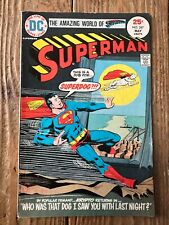
Superman 287 FN- 5.5 Fine- Krypto Superdog Cover Bronze Age 1975 DC Comics $6.99
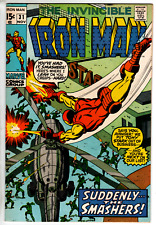
Iron Man #31, Very Fine Condition $25.00
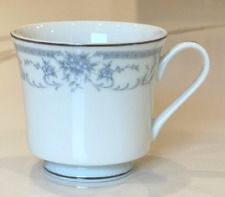
1985 Sheffield Blue Whisper Fine China Footed Tea Cup ONLY Made Japan Vintage $8.95

1985 Sheffield Blue Whisper Fine China Footed Tea Cup ONLY Floral Japan Vintage $8.95

1985 Sheffield Blue Whisper Fine China Footed Tea Cup ONLY Japan Vintage $8.95
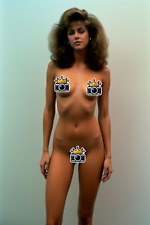
FINE ART} NUDE MODEL |PHOTO 8X10 COLLECTIBLE PHOTO 121503 $5.95
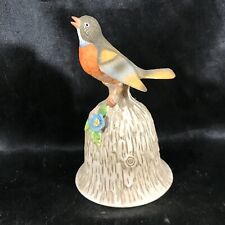
Vintage TOWLE Fine Bone China Robin Bird Bell Porcelain $9.60
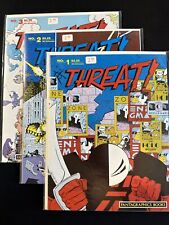
Threat #1 2 3 Comic Magazine Fantagraphics 1986 Lot Run Set Very Fine $13.99
|